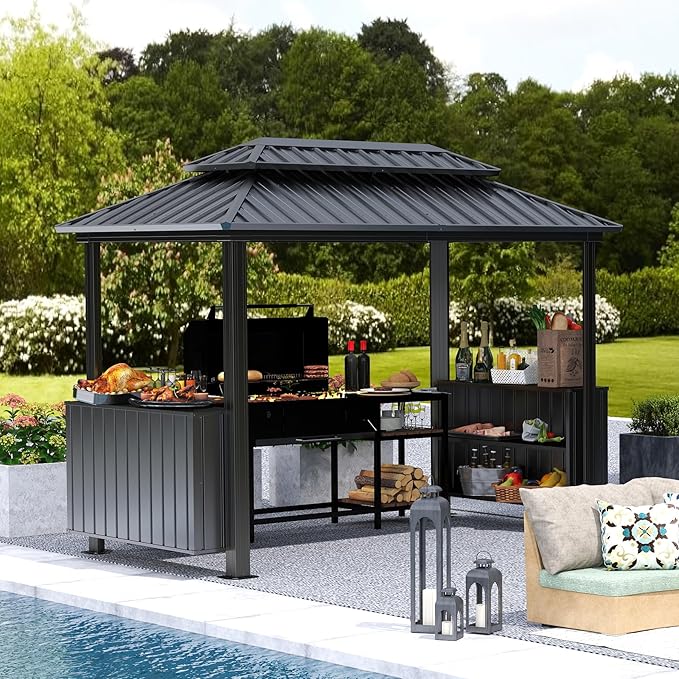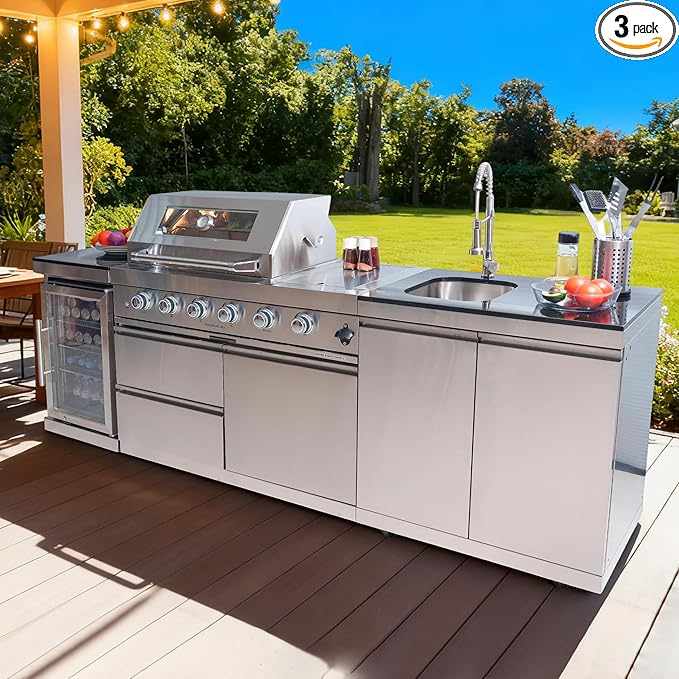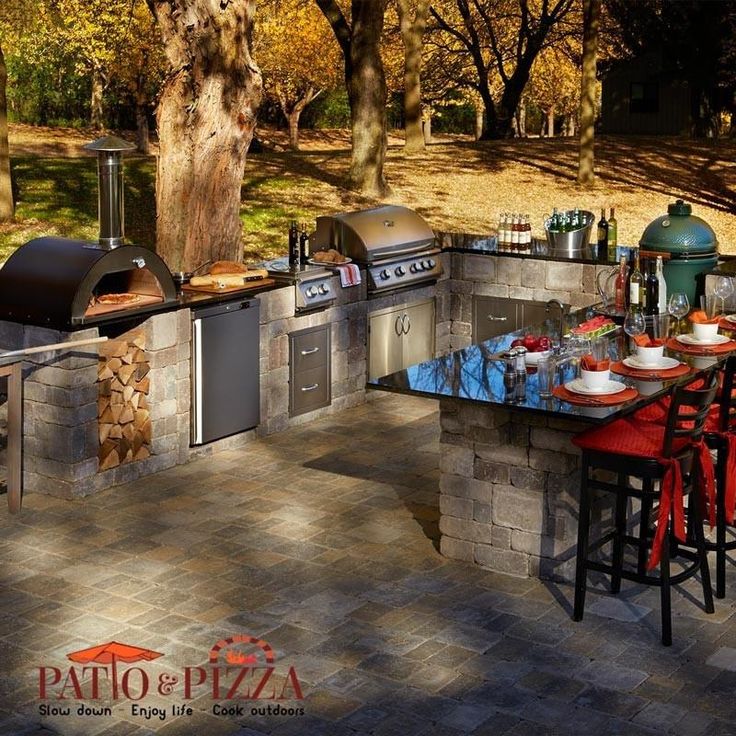There’s a moment every backyard cook dreams of — that perfect sizzle. The instant a steak hits blazing-hot metal and releases a burst of smoke that smells like pure satisfaction. It’s not luck. It’s not guesswork. It’s the science and precision of the sear burner — the secret weapon behind restaurant-quality crusts and tender, juicy centers.
Most home grills can’t replicate that high-end steakhouse magic because they simply don’t reach the intense heat required to caramelize the meat’s surface instantly. But a gas grill with a dedicated sear burner changes everything. It ignites faster, burns hotter, and seals in flavor in seconds. One good sear, and suddenly your backyard feels like a chef’s stage.
Whether you’re cooking ribeyes, tomahawks, or scallops, mastering the sear burner means you’re not just grilling anymore — you’re crafting experiences. Each meal becomes a showcase of precision, flavor, and control. The kind that makes guests go silent with that first bite — and then ask, “How did you make this at home?”

Understanding What a Sear Burner Actually Does
Ever noticed how a steak from a high-end restaurant carries that smoky crust with a perfect pink center? That’s the sear — a quick burst of extreme heat that transforms the surface of meat into a caramelized masterpiece. A sear burner is a specialized section on a gas grill designed to reach higher temperatures than regular burners. It doesn’t just cook; it creates flavor chemistry. When the surface of your meat meets that concentrated flame, it triggers the Maillard reaction — a complex process that brings out those deep, savory, irresistible aromas.
But here’s where most home cooks miss out…
They rely on regular burners that max out too soon. Without enough heat, the meat steams instead of sears, leaving a pale, uneven finish. A proper sear burner solves that by generating intense, direct heat — the kind you feel instantly when you open the lid. It’s not just about temperature; it’s about control. With the right setup, you can seal in juices within seconds while locking in that golden crust chefs swear by.
So, if you’ve ever wondered why your steaks don’t taste like the ones from your favorite steakhouse — the answer is probably hiding inside that sear zone.
Why a Gas Grill Sear Burner is a Game-Changer
Here’s the truth — once you cook with a sear burner, you’ll never go back.
A gas grill equipped with this feature takes outdoor cooking to another level. It’s not only about power; it’s about precision. The high heat from the sear zone doesn’t just brown food — it caramelizes natural sugars, rendering fat and sealing moisture inside. The result? Steaks that sing with flavor and texture that melts on the tongue. And it’s not limited to meat. Fish, burgers, even vegetables get that glossy, restaurant-grade finish that regular burners can’t match.
But wait, there’s more…
That quick sear also cuts down your cooking time dramatically. Instead of hovering over the grill, you get rapid, even heat distribution. Plus, your food keeps that smoky essence without the dryness that comes from prolonged heat exposure. It’s the perfect balance of power and finesse — something only a sear burner can deliver consistently. Once you master it, you’re not just grilling anymore. You’re crafting flavor at a professional level — right in your backyard.
Choosing the Right Gas Grill with a Sear Burner
Not all grills are created equal — and that’s especially true when it comes to sear performance.
Before investing in one, think about what you really need. The best models offer high BTU output, durable stainless steel components, and responsive heat control. A quality sear zone should feel like a mini furnace when preheated, not a warm patch on the side. Look for even flame coverage across the burner and materials that resist corrosion, like 304 stainless steel.
Here’s where many shoppers slip up…
They focus on size over function. A compact unit with a powerful sear zone often outperforms larger, poorly designed models. Freestanding designs, like those offered by Holagrills, combine portability with pro-grade performance. Meanwhile, built-in options fit seamlessly into outdoor kitchens for those seeking a permanent setup. Whether you prefer a minimalist patio look or a full chef’s station, there’s a model designed to match your lifestyle — and your flavor goals.
Setting Up Your Sear Burner Like a Pro
Ready to fire it up? Hold on — setup makes or breaks the sear.
Start with preheating. Let your sear burner run for at least 10 minutes until it glows red-hot. That’s when it reaches its true searing potential. Skip this step, and your results will fall flat. Next, position your meat at a slight angle to the grates to maximize surface contact and create those signature diamond grill marks.
But here’s a quick tip most people overlook…
Don’t use oil directly on the burner. Instead, lightly brush it on the food itself to prevent sticking. Control is key — switch between high and medium zones when moving thicker cuts to avoid burning the exterior before the inside cooks through. Use a temperature gauge if your grill has one, and always close the lid between flips to maintain consistent heat. The secret isn’t speed — it’s balance. With the right rhythm, your sear burner becomes a tool of precision, not just power.
The Step-by-Step Method to Perfectly Sear a Steak
Let’s turn that heat into magic.
First, bring your meat to room temperature. This small step ensures even cooking from edge to center. Pat it dry — moisture is the enemy of searing — and season generously with salt and pepper. Once your grill is blazing, place the steak directly over the sear zone. You’ll hear that sharp hiss of perfection — that’s flavor forming.
Here’s where timing matters most…
Sear each side for about 60–90 seconds. Avoid moving it around — those few seconds of stillness are what create the crust. Then, shift it to a cooler area to finish cooking slowly to your preferred doneness. Use a thermometer for accuracy rather than guessing. Finally, rest the steak for five minutes before slicing to let juices settle evenly.
The reward? A crust so crisp it crackles when you cut through, revealing a tender, rosy center bursting with natural flavor. That’s not luck — it’s the power of mastering your sear burner.

Beyond Steaks – What Else You Can Cook on a Sear Burner
Think the sear zone is only for steak? Think again.
A sear burner can transform just about any ingredient into something exceptional. Seafood, for instance, takes on an entirely new life under intense heat. Shrimp develop that smoky snap, salmon gets a crisp skin, and scallops brown beautifully without overcooking inside. For poultry, that quick, fiery kiss helps seal in juices while creating an irresistible golden crust — perfect for chicken thighs, drumsticks, or even duck breasts.
But here’s a fun twist…
You can also use the sear burner for vegetables and sides. Sliced peppers, corn, and asparagus char perfectly, adding color and complexity to any plate. Even tofu and plant-based proteins benefit from that high-heat caramelization, turning bland into bold. With a little creativity, the sear burner becomes more than a steak tool — it’s a flavor amplifier. Whether you’re prepping kebabs, searing tuna, or finishing burgers with that final crust, versatility is the real win. The next time you light up your grill, challenge yourself: what else can this burner do for you?
Maintenance and Cleaning Tips for Your Sear Burner
A well-maintained grill doesn’t just perform better — it lasts longer.
After each session, allow the burner to cool slightly before brushing off debris with a grill-safe brush. Avoid using water directly on a hot surface, as sudden temperature changes can cause damage. Instead, use a damp cloth once it’s warm to loosen any stuck-on residue. Regular cleaning prevents grease build-up, which can block ports and reduce heat output.
But here’s the golden rule…
Once a month, remove the grate and inspect the infrared plate or ceramic element. Wipe it gently to remove soot, and check for any cracks or discoloration that signal wear. If you notice uneven heating or small flame gaps, a deep clean is due. For heavy users, consider replacing your sear grate annually to maintain consistent results. A clean burner isn’t just about hygiene — it’s about performance. Each time you fire it up, you want those flames burning bright, clean, and even, ensuring that every sear tastes as incredible as the first.
Troubleshooting Common Sear Burner Issues
Even the best grills need a little attention sometimes.
If your sear burner isn’t heating evenly, start by checking for blockages in the ports. Grease or debris can restrict gas flow, leading to weak or patchy flames. A quick clean with a fine brush usually restores full power. Notice a yellow or flickering flame? That’s often a sign of poor air-to-gas ratio — something a simple vent adjustment can fix.
Now, here’s where most people panic…
When the burner won’t ignite, it’s rarely a serious problem. Start by confirming your gas supply, then check the igniter battery or wiring for corrosion. A spark test can help identify faults. In many cases, a small cleaning or battery replacement gets things roaring again. For infrared models, avoid scraping the ceramic surface; use compressed air or a soft brush instead. Remember, consistent maintenance means fewer surprises — and a sear burner that performs like new, season after season.
Comparing Sear Burners with Other High-Heat Cooking Methods
Searing isn’t exclusive to grills — but nothing does it quite like a gas burner.
Pan-searing delivers flavor, yes, but it often lacks that smoky edge and evenly distributed heat you get from open flame. Cast iron pans create excellent crusts but demand constant monitoring and limited space. Meanwhile, infrared sear burners offer concentrated, uniform heat that spreads instantly across the surface, producing restaurant-quality texture with less effort.
Here’s what most home cooks don’t realize…
Ceramic elements and traditional burners may reach similar temperatures, but infrared burners waste less fuel while delivering more direct heat. That efficiency translates into better sears and lower gas consumption. Chefs love infrared zones for their speed, precision, and control — they can bring a steak to crust perfection in under two minutes. For those who crave that balance between texture and tenderness, the sear burner wins every comparison. It’s not just fast cooking — it’s smart heat.
Taking Your Grilling Skills to the Next Level
You’ve mastered the flame. Now it’s time to refine the art.
Experimentation is where grilling becomes personal. Try marinating meats with olive oil, garlic, or a dash of soy for deeper flavor. Dry rubs with smoked paprika or cracked pepper also perform beautifully under high heat, creating a crust that snaps with every bite. For advanced techniques, combine searing with reverse cooking — sear first for crust, then finish at lower heat to retain tenderness.
But here’s the real secret…
Grilling is not just about food — it’s about timing and intuition. Know when to close the lid, when to rest, and when to let the heat do its magic. Pair your cuts with the right sides: charred corn, roasted vegetables, or even grilled peaches for a sweet twist. Each session on the grill becomes a chance to sharpen skill and palate. With time, your grill becomes more than a tool — it becomes your signature.
Final Thoughts – Bringing Restaurant-Quality Results Home
Every great meal begins with fire — but true mastery comes from control.
The sear burner bridges that gap between amateur and artisan, giving backyard cooks the same edge professional chefs rely on. It’s not about fancy techniques or secret marinades; it’s about precision, temperature, and timing. With the right grill setup, even a simple cut of meat transforms into something worth remembering — rich color, crisp crust, and flavor that lingers long after the last bite.
But here’s the best part…
You don’t need a restaurant kitchen or years of training to make it happen. A well-designed gas grill with a sear zone gives you all the tools you need. Once you understand its rhythm, it becomes second nature — fast ignition, powerful heat, flawless control. Whether it’s steak night with family or a weekend BBQ with friends, every session turns into a show.
Holagrills’ precision-built stainless steel models, with durable construction and responsive heat zones, make achieving that perfection effortless. Because when your equipment performs at its best, so do you. And that’s how you turn ordinary meals into unforgettable moments — one perfect sear at a time.

FAQs
Q1: How long should I preheat my sear burner before cooking?
Around 10 minutes is ideal. This allows the surface to reach high heat for proper caramelization without burning your food.
Q2: Can I use the sear burner for delicate foods like fish or shrimp?
Yes. Reduce the intensity slightly and monitor closely — seafood sears quickly, often within 30–60 seconds per side.
Q3: Why does my food stick to the grill during searing?
The grate isn’t hot enough or the surface is wet. Always preheat fully and pat ingredients dry before placing them on the burner.
Q4: What’s the difference between a sear burner and a regular gas burner?
A sear burner generates higher, more concentrated heat, creating faster crusts and richer flavor development than standard burners.
Q5: How often should I clean my sear burner?
After each session, remove debris while warm. Perform a deeper clean monthly to keep heat output strong and even.
Q6: Do I need special fuel for a sear burner?
No. Most models use standard propane or natural gas. Just ensure a consistent fuel supply and proper pressure for full performance.
Q7: Can I install a sear burner on an existing grill?
In some cases, yes. Many brands offer retrofit kits compatible with certain models — check manufacturer specifications first.
Q8: What temperature should I aim for when searing steak?
The surface should reach about 700–900°F for optimal crust formation. Use a thermometer to maintain accuracy.
